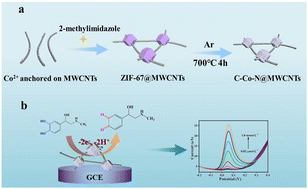3D C–Co–N-anchored MWCNTs derived from metal–organic frameworks as high-performance electrochemical sensing platforms for the sensitive detection of adrenaline†
Abstract
Metal–organic frameworks (MOFs) are composed of metal ions and organic ligands with high specific surface areas, controllable porous structures and abundant metal active sites, showing their extraordinary potential in electrochemical sensors. Here, a 3D conductive network structure (C–Co–N@MWCNTs) is designed by anchoring zeolite imidazole frameworks (ZIF-67) onto multi-walled carbon nanotubes (MWCNTs) and carbonizing them. The C–Co–N@MWCNTs exhibit excellent electron conductivity, a porous structure and considerable electrochemical active sites, which can effectively demonstrate high sensitivity and selectivity in the detection of adrenaline (Ad). The Ad sensor exhibited a low detection limit of 6.7 nmol L−1 (S/N = 3) and a wide linear range of 0.02 μmol L−1–1.0 mmol L−1. The developed sensor also displayed high selectivity, good reproducibility and repeatability. The C–Co–N@MWCNTs electrode was further employed in the detection of Ad in a real sample of human serum, suggesting that it is a promising candidate for electrochemical sensing of Ad.



 Please wait while we load your content...
Please wait while we load your content...